Dartmoor: Difference between revisions
Created page with 'right|thumb|350px|Up the River Meavy towards Sharpitor and Leather Tor '''Dartmoor''' is a vast moorland in south Devon. A rough, i…' |
|||
| (One intermediate revision by the same user not shown) | |||
| Line 106: | Line 106: | ||
There are also an estimated 5,000 hut circles still surviving, despite the fact that many have been raided over the centuries by the builders of the traditional dry stone walls. These are the remnants of Bronze Age houses. The smallest are around 6 feet in diameter, and the largest may be up to five times this size. | There are also an estimated 5,000 hut circles still surviving, despite the fact that many have been raided over the centuries by the builders of the traditional dry stone walls. These are the remnants of Bronze Age houses. The smallest are around 6 feet in diameter, and the largest may be up to five times this size. | ||
Some have L-shaped porches to protect against wind and rain; some particularly good examples are to be found at Grimspound. It is believed that they would have had a conical roof, supported by timbers and covered in turf or thatch. | Some have L-shaped porches to protect against wind and rain; some particularly good examples are to be found at [[Grimspound]]. It is believed that they would have had a conical roof, supported by timbers and covered in turf or thatch. | ||
There are also numerous kistvaens; Neolithic stone box-like tombs. | There are also numerous kistvaens; Neolithic stone box-like tombs. | ||
| Line 280: | Line 280: | ||
{{Catself}} | {{Catself}} | ||
[[Category: | [[Category:Devon moors]] [[Category:Devon]] | ||
Latest revision as of 17:57, 9 April 2019
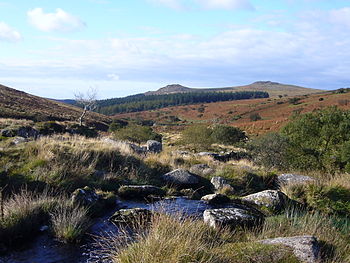
Dartmoor is a vast moorland in south Devon. A rough, infertile land, grazed by hardy beasts, it provides spectacular scenery. It takes its name from the River Dart, which rises in the middle of the high moor as two rivers, the East Dart and West Dart, though the moor is the source of several of Devon's great rivers.
Dartmoor is, geologically, a vast lump of granite, which stone shapes and colours the landscape and the villages of the moor. The moor rises to its highest point at 2,037 feet on High Willhays, Devon's county top, and the whole moor is a great range of hills, many capped with dramatic exposed granite tops. The hills are known as tors, though geologists use that term for the exposed tops (which appears indeed to be the origin of the word if not the local usage).
The moor has a variety of landscapes; the high moor is a wind-blasted, bleak highland of exposed open moorland which is the heart of the moor. Around the high moor though are the gentler, green valleys and enclosed fields of the Dartmoor farms, still with the moor's thin soil through which the rock breaks through frequently but providing a living to the farmers of south Devon.
Dartmoor wildlife varies. The highest point is High Willhays, 2,037 feet above sea level. The entire area is rich in antiquities and archaeology.
Parts of Dartmoor have been used as military firing ranges for over 200 years. The public enjoy extensive access rights to Dartmoor (including restricted access to the firing ranges) and it is a popular tourist destination.
National Park
The Dartmoor National Park was created by statute and covers 368 square miles.
The Park is managed by the Dartmoor National Park Authority, whose 22 members are drawn from local authorities and Government.
Physical geography
Geology
Dartmoor includes the largest area of granite in Britain, with about 240 square miles at the surface, though most of it is under superficial peat deposits. The granite was intruded at depth as a pluton into the surrounding sedimentary rocks during the Carboniferous period, probably about 309 million years ago.[1] It is generally accepted that the present surface is not far below the original top of the pluton; evidence for this includes partly digested shale xenoliths, contamination of the granite and the existence of two patches of altered sedimentary rock on top of the granite.[2] It is believed that the Dartmoor granite is part of one vast granite basolith surfacing as Dartmoor, Bodmin Moor, the Penwith peninsula and the Isles of Scilly.
A considerable gravity anomaly is associated with the Dartmoor pluton as with other such plutons. Measurement of the anomaly has helped to determine the likely shape and extent of the rock mass at depth.

Tors
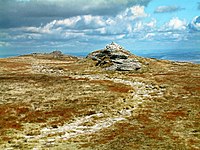
Dartmoor is known for its distinctive hills, commonly topped with outcrops of the granite bedrock, which are usually rounded boulder-like formations. Geologists name the outcrops "tors", though locally "tor" is simply the name for a hill, and more than 160 of the hills of Dartmoor have the word tor in their name, regardless of whether or not there is an outcrop of rock on their top.
The tors are the focus of an annual event known as the Ten Tors Challenge, when around 2,400 people aged between 14 and 19 walk for distances of 35, 45 or 55 miles between ten tors on many differing routes.
The highest points on Dartmoor are two neighbouring tops on the northern moor:
- High Willhays, 2,037 feet, (SX580895)
- Yes Tor, 2,031 feet, (SX581901)
Rivers
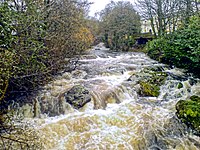
The high ground of Dartmoor is the source of many of Devon's rivers. As well as shaping the landscape, these have traditionally provided a source of power for moor industries such as tin mining and quarrying.
The chief rivers rising on the moor are:
- The River Dart, from which the moor takes its name. It starts as the East Dart and West Dart and then becomes a single river at Dartmeet. It leaves the moor at Buckfastleigh, flowing through Totnes below where it opens up into a long estuary, reaching the sea at Dartmouth.
- The River Okement, beginning as the East Okement and the West Okement and flowing north to Okehampton
- The River Taw, entering the Bristol Channel after joining in the River Torridge
- The River Teign, flowing east to open into a long estuary north of Tor Bay
- The River Tavy, heading southwest to Tavistock and ultimately to the River Tamar.
Bogs
Much more rain falls on Dartmoor than in the surrounding lowlands. As much of the moor is covered in thick layers of peat, the rain is usually absorbed quickly and distributed slowly, so the moor is rarely dry. In areas where water accumulates, dangerous bogs or mires can result. Some of these, topped with bright green moss, are known to locals as "feather beds" or "quakers", because they shift (or 'quake') beneath your feet. Quakers result from sphagnum moss growing over the water that accumulates in the hollows in the granite.[3][4][5]
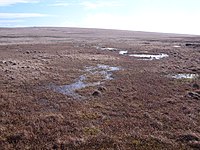
The vegetation of the bogs depends on the type and location. Blanket bog, which forms on the highest land where the rainfall exceeds 80 inches a year, consists mainly of cotton-grass (Eriophorum species), sedges (Carex and Rhynchospora), Bog Asphodel and Common Tormentil, with Sphagnum thriving in the wettest patches. The valley bogs have lush growth of Juncaceae|rushes, with sphagnum, cross-leaved heath, sundews and several other species.[6]
Some of the bogs on Dartmoor have achieved notoriety, the most notable being Fox Tor Mires, supposedly the inspiration for Great Grimpen Mire in Conan Doyle's novel The Hound of the Baskervilles,[7] although there is a waymarked footpath across it.
The Rev Sabine Baring-Gould, in his Book of Dartmoor (1900) related the local tale of a man who was making his way through Aune Mire at the head of the River Avon when he came upon a top-hat brim down on the surface of the mire. He kicked it, whereupon a voice called out: "What be you a-doin' to my 'at?" The man replied, "Be there now a chap under'n?" "Ees, I reckon," was the reply, "and a hoss under me likewise."[8]
History
Pre-history
The majority of the prehistoric remains on Dartmoor date back to the late Neolithic and early Bronze Age. Indeed, Dartmoor contains the largest concentration of Bronze Age remains in the United Kingdom, which suggests that this was when a larger population moved onto the hills of Dartmoor. The large systems of Bronze Age fields, divided by reaves, cover an area of over 24,700 acres of the lower moors.[9]
The climate at the time was warmer than today, and much of today's moorland was covered with trees. The prehistoric settlers began clearing the forest, and established the first farming communities. Fire was the main method of clearing land, creating pasture and swidden types of fire-fallow farmland. Areas less suited for farming tended to be burned for livestock grazing. Over the centuries these Neolithic practices greatly expanded the upland moors, and contributed to the acidification of the soil and the accumulation of peat and bogs.[10]
The highly acidic soil has ensured that no organic remains have survived, but the durability of the granite has meant that the remains of buildings, enclosures and monuments have survived well, as have flint tools. It should be noted that a number of remains were "restored" by enthusiastic Victorians and that, in some cases, they have placed their own interpretation on how an area may have looked.
Standing stones
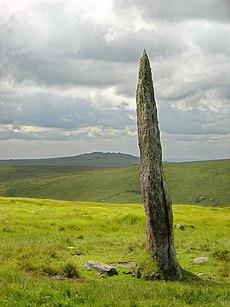
Numerous prehistoric standing stones or longstones), stone circles (hut circles), kistvaens, cairns and stone rows are to be found on the moor. The most significant sites include:
- Upper Erme stone row is the longest on Dartmoor and in fact in the world at 3,600 yards.
- Beardown Man, near Devil's Tor: an isolated standing stone 11½ feet high, said to have another 3 feet below ground (SX596796)
- Challacombe, near the prehistoric settlement of Grimspound: a triple stone row (SX689807)
- Drizzlecombe, east of Sheepstor village: stone circles, rows, standing stones, kistvaens and cairns. SX591669
- Grey Wethers, near Postbridge: a double circle, aligned almost exactly north south. SX638831
- Laughter Tor, near Two Bridges: a standing stone 9 feet high and two double stone rows, one 180 yards long. SX652753
- Merrivale, between Princetown and Tavistock: includes a double stone row 200 yards long, over a yard wide, aligned almost exactly east-west), hut circles and a kistvaen. SX554747
- Scorhill (pronounced 'Scorill'), west of Chagford: circle, 88 feet in circumference, and stone rows. SX654873
- Shovel Down, north of Fernworthy reservoir: double stone row approximately 130 yards long. SX660859
- Yellowmead Down, a quadruple concentric stone circle and stone rows.
Hut circles and kistvaens
There are also an estimated 5,000 hut circles still surviving, despite the fact that many have been raided over the centuries by the builders of the traditional dry stone walls. These are the remnants of Bronze Age houses. The smallest are around 6 feet in diameter, and the largest may be up to five times this size.
Some have L-shaped porches to protect against wind and rain; some particularly good examples are to be found at Grimspound. It is believed that they would have had a conical roof, supported by timbers and covered in turf or thatch.
There are also numerous kistvaens; Neolithic stone box-like tombs.
Many ancient structures, including the hut circles at Grimspound, were reconstructed during the 19th century; most notably by civil engineer and historian Richard Hansford Worth. Some of this work was based more on speculation than archaeological expertise, and has since been criticised for its inaccuracy.
The historical period
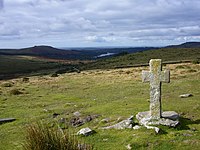
The climate worsened over the course of a thousand years from around 1000 BC, so that much of high Dartmoor was largely abandoned by its early inhabitants.
It was not until the early mediæval period that the weather again became warmer, and settlers moved back onto the moors. Like their ancient forebears, they also used the natural granite to build their homes, preferring a style known as the longhouse, some of which are still inhabited today, although they have been clearly adapted over the centuries. Many are now being used as farm buildings, while others were abandoned and fell into ruin.
The earliest surviving farms, still in operation today, are known as the Ancient Tenements. Most of these date back to the 14th century and sometimes earlier.
Some way into the moor stands the town of Princetown, the site of Dartmoor Prison, which was originally built both by, and for, prisoners of war from the American War of Independence and from the Napoleonic Wars. The prison has a reputation for being escape-proof, due to both the buildings themselves and its physical location.
The Dartmoor landscape is scattered with the marks left by the many generations who have lived and worked there over the centuries — such as the remains of the once mighty Dartmoor tin-mining industry, and farmhouses long since abandoned.
Myths and literature
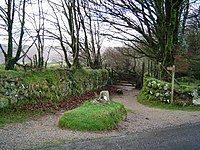
Dartmoor abounds with myths and legends. It is reputedly the haunt of pixies, a headless horseman, a mysterious pack of 'spectral hounds', and a large black dog. During the Great Thunderstorm of 1638, Dartmoor town of Widecombe-in-the-Moor was even said to have been visited by the Devil.
Many landmarks have ancient legends and ghost stories associated with them, such as Jay's Grave, the ancient burial site at Childe's Tomb, the rock pile called Bowerman's Nose, and the stone crosses that mark mediæval routes across the moor.
A few stories have emerged in recent decades, such as the 'hairy hands', that are said to attack travellers on the B3212 near Two Bridges;[11] and the 'Beast of Dartmoor', a supposed large cat.[12]
Dartmoor has inspired a number of artists and writers, such as Sir Arthur Conan Doyle in The Hound of the Baskervilles and The Adventure of Silver Blaze, Eden Phillpotts, Beatrice Chase, Agatha Christie, Rosamunde Pilcher, Laurie King, and the Reverend Sabine Baring-Gould.
Ownership and access
Of the Dartmoor National Park, 57.3% is private land; the Forest of Dartmoor being the major part of this, owned by the Duchy of Cornwall. The Ministry of Defence owns 14% (see below), 3.8% is owned by water companies (see Dartmoor reservoirs), 3.7% by the National Trust, 1.8% by the Forestry Commission and 1.4% by Dartmoor's national park authority. About 37% of the National Park is common land.[13]
Dartmoor differs from some other National Parks, in that since the Dartmoor Commons Act 1985[14] much of it has been designated as 'Access Land', which, although it remains privately owned, has no restrictions on where walkers can roam. In addition to this Access Land, there are about 450 miles of public rights of way on Dartmoor, and many miles of permitted footpaths and bridleways where the owner allows access.[15]
Because of the 1985 Act, Dartmoor was largely unaffected by the Countryside and Rights of Way Act 2000, which established similar rights in other rural parts of the country, but in 2006, this Act opened up much of the remaining restricted land to walkers.
Use by the Ministry of Defence
There is a practice of military usage of Dartmoor dating back to the Napoleonic wars. There is still a large Army training camp at Okehampton, which was also the site of an airbase during the Second World War. The moor provides a peeless hardy environment for training soldiers in harsh conditions and endurance.
The Ministry of Defence uses three areas of the northern moor for manoeuvres and live-firing exercises, totalling 42 square miles, or just over 11% of the National Park. Red and white posts mark the boundaries of these military areas (shown on Ordnance Survey 1:25,000 scale maps). Flagpoles on many tors in and around the ranges fly red flags when firing is taking place. At other times, members of the public are allowed access. Blank rounds may also be used, but the MoD does not notify the public of this in advance.
Some "challenge" and charitable events take place with assistance of the military on Dartmoor including the long established Ten Tors event and the more recent Dartmoor Beast.
Landmarks
- Black Tor Beare – remote woodland of stunted oaks over 1,000 feet above sea level in the West Okement valley
- Bowerman's Nose – unusual rock formation
- Brentor Church – remote church standing 1,128.61 above sea level on top of a crag at the western edge of the moor.
- Burrator Reservoir – late Victorian reservoir
- Castle Drogo – Edwardian faux castle built by Edwin Lutyens on crag above Teign Gorge, Drewsteignton
- Childe's Tomb – ancient burial site
- Church House, South Tawton – 15th century church ales house
- Cosdon or Cawsand Beacon – prominent hill, northern extremity of moor, site of beacon fire for invasion warning
- Cranmere Pool – original letterbox site and location of the legend of Cranmere Binjie
- Crazywell Pool – artificial lake
- Dartmeet – meeting point of East and West Dart
- Devonport Leat – man-made water channel
- Duck's Pool – location of a memorial to local writer William Crossing
- Fernworthy Dam & Reservoir – granite-faced concrete dam and lake in Fernworthy Forest, nr. Chagford
- Great Links Tor – dominant tor on NW scarp of moor
- Grey Wethers – pair of ancient stone circles
- Grimspound – Bronze Age settlement
- Haytor Granite Tramway – remarkable early tramway with stone rails; ran from quarries at Haytor to Stover Canal
- Haytor Rock – prominent tor and viewpoint between Bovey Tracey and Widecombe
- High Willhays – highest point on Dartmoor and in all Devon
- Hound Tor – rugged tor with remains of Iron Age village
- Jay's Grave – mysterious burial site
- Lydford Gorge – dramatic, very deep and narrow gorge with waterfalls
- Meldon dam & viaduct – concrete dam 660 feet long and 148 feet high and dramatic Victorian iron viaduct which itself is 541 feet long and 150 feet high.
- Powdermills – remains of gunpowder grinding mill near Two Bridges
- Rattlebrook railway – remains of horse-worked railway track to peat works near Great Links Tor
- Scorhill stone circle – (Pronounced 'Scorill') well-preserved circle of standing stones near Teign-e-ver, Gidleigh
- Sheepstor; parish church is the burial place of the Brooke dynasty; the Rajahs of Sarawak
- Skaigh Valley – narrow, wooded valley leading up on to moor at Belstone; on famous Sticklepath geological fault
- Tavistock Canal – 19th century canal
- Tavy Cleave – dramatic river gorge on western moor near Mary Tavy
- Teign-e-ver – confluence of North Teign and Wallabrook; clapper bridges & tolmen stone
- Two Bridges – 18th century coaching inn
- Wheal Betsy – engine house of mine on Blackdown, Mary Tavy
- Widgery Cross – granite cross atop Brat Tor, memorial erected by Dartmoor artist William Widgery to commemorate the Golden Jubilee of Queen Victoria in 1887
- Wistman's Wood – remote copse of stunted oaks in valley of West Dart near Two Bridges
- White Hart Hotel – historic 17th century coaching inn in Moretonhampstead
Leisure activities
Until the early 19th century Dartmoor was not considered to be a place worth visiting: in the 1540s John Leland wrote in his Itinerary that "Dartmore is muche a wilde Morish and forest Ground", and even by 1789 Richard Gough's opinion was that it is a "dreary mountainous tract".[16] At the turn of the 19th century John Swete was one of the first people to visit Dartmoor for pleasure and his journals and watercolour paintings now provide a valuable historical resource.[17]
The oldest leisure pursuit on the moor is hill walking. William Crossing's definitive Guide to Dartmoor was published in 1909, and in 1938 a plaque and letterbox in his memory were placed at Duck's Pool on the southern moor. Parts of the Two Moors Way and the Templer Way are on Dartmoor.[18]
Letterboxing originated on Dartmoor in the 19th century and has become increasingly popular in recent decades. Watertight containers, or 'letterboxes', are hidden throughout the moor, each containing a visitor's book and a rubber stamp. Visitors take an impression of the letterbox's rubber stamp as proof of finding the box and record their visit by stamping their own personal stamp in the letterbox's logbook. A recent related development is geocaching. Geocache clues make use of GPS coordinates, whereas letterboxing clues tend to consist of grid references and compass bearings.
Whitewater kayaking and canoeing are popular on the rivers due to the high rainfall and their high quality,[19] though for environmental reasons access is restricted to the winter months.[20] The River Dart is the most prominent meeting place, the section known as the Loop being particularly popular. Other white water rivers are the Erme, Tavy, Plym and Meavy.
Other activities are rock climbing on the granite tors and outcrops, some of the well-known venues being Haytor, Hound Tor and The Dewerstone;[21] horse riding, which can be undertaken on any of the common land;[22] cycling (but not on open moorland);[23] and angling for wild brown trout, sea trout and salmon, although much of the river fishing on Dartmoor is privately owned, permits are available for some stretches.[24]
Outside links
| ("Wikimedia Commons" has material about Dartmoor) |
References
- ↑ Durrance & Laming 1982, pp.86, 101
- ↑ Durrance & Laming 1982, p.88
- ↑ Ian Mercer: Bogs and Mires of Dartmoor, in Hunt & Wills, 1977, p.16.
- ↑ Sandles, Tim. "The Bogs & Mires of Dartmoor". Legendary Dartmoor. http://www.legendarydartmoor.co.uk/bogs_moor.htm. Retrieved 2009-07-12.
- ↑ Crossing, W, Crossing's Guide to Dartmoor 1912 edition, published by Western Morning News Co. Ltd.
- ↑ Brunsden, Denys; Gerrard, John (1970). "The Physical Environment of Dartmoor". in Crispin Gill. Dartmoor. A New Study. Newton Abbot: David and Charles. pp. 40–42. ISBN 0-7153-5041-2.
- ↑ Sandles, Tim. "Dartmoor's Notorious Fox Tor Mires". Legendary Dartmoor. http://www.legendarydartmoor.co.uk/grim_mire.htm. Retrieved 2009-07-07.
- ↑ Milton 2006, p.2
- ↑ "Prehistoric Dartmoor". Dartmoor National Park Authority. http://www.dartmoor-npa.gov.uk/index/lookingafter/laf-culturalheritage/laf-archaeology/laf-prehistoricdartmoor.htm. Retrieved 2009-09-02.
- ↑ Role of anthropogenic fire and in creating moors, and moor-burning in sustaining them, described in #refPyne1997|Pyne 1997, pp. 348-369.
- ↑ Sandles, Tim. "The Hairy Hands". Legendary Dartmoor. http://www.legendarydartmoor.co.uk/hairy_hands.htm. Retrieved 2010-08-07.
- ↑ Sandles, Tim. "The Legendary Beast of Dartmoor". Legendary Dartmoor. http://www.legendarydartmoor.co.uk/beast_dart.htm. Retrieved 2010-08-07.
- ↑ "Dartmoor Commons" (PDF). Dartmoor National Park Authority. http://www.dartmoor-npa.gov.uk/print/lab-comm.pdf. Retrieved 2008-03-19.
- ↑ Dartmoor Commons Act 1985 on the OPSI website
- ↑ "Public Rights of Way". Dartmoor National Park Authority. http://www.dartmoor-npa.gov.uk/vi-prow. Retrieved 2009-07-14.
- ↑ Milton 2006, pp.19–20
- ↑ Milton 2006, p.36
- ↑ "Walking For All". Dartmoor National Park Authority. http://www.dartmoor-npa.gov.uk/index/visiting/vi-enjoyingdartmoor/vi-walkingforall.htm. Retrieved 2009-07-12.
- ↑ "South West England". UK Rivers Guidebook. http://www.ukriversguidebook.co.uk/swengland/swengland.htm. Retrieved 2010-04-18.
- ↑ "Canoeing". Dartmoor National Park Authority. http://www.dartmoor-npa.gov.uk/index/visiting/vi-enjoyingdartmoor/vi-canoeing.htm. Retrieved 2009-07-12.
- ↑ "Climbing". Dartmoor National Park Authority. http://www.dartmoor-npa.gov.uk/index/visiting/vi-enjoyingdartmoor/vi-climbing.htm. Retrieved 2009-07-10.
- ↑ "Horse Riding". Dartmoor National Park Authority. http://www.dartmoor-npa.gov.uk/index/visiting/vi-enjoyingdartmoor/vi-horse-riding.htm. Retrieved 2009-07-12.
- ↑ "Cycling on road and off road". Dartmoor National Park Authority. http://www.dartmoor-npa.gov.uk/index/visiting/vi-enjoyingdartmoor/vi-cycling.htm. Retrieved 2009-07-12.
- ↑ "Other Activities". Dartmoor National Park Authority. http://www.dartmoor-npa.gov.uk/index/visiting/vi-enjoyingdartmoor/vi-otheractivities.htm. Retrieved 2009-07-10.
Books
- Crossing, William: Crossing's Guide to Dartmoor, the 1912 edition reprinted with new introd. by Brian Le Messurier. Dawlish: David & Charles, 1965.
- Durrance, E. M.; Laming, D. J. (1982). The Geology of Devon. University of Exeter. ISBN 0-85989-247-6.
- Hunt, P. J.; Wills, G. L. (eds) (1977), Devon Wetlands, Exeter: Devon County Council ISBN 0-903849-19-4.
- Milton, Patricia (2006). The Discovery of Dartmoor, a Wild and Wondrous Region. Chichester: Phillimore. ISBN 1-86077-401-6.
- Pyne, Stephen J. (1997) Vestal Fire: an Environmental History, Told through Fire, of Europe and Europe's Encounter with the World. University of Washington Press, Seattle ISBN 0-295-97596-2.
- Webb, Bruce (2006). "The Environmental Setting of Human Occupation". in Roger Kain. England's Landscape: The South West. London: Collins. pp. 30–33. ISBN 0-00-715572-7.
